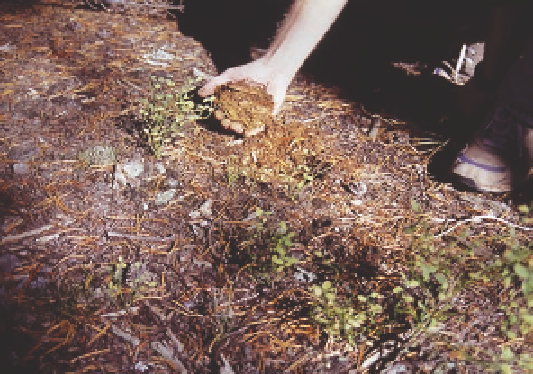Geoscience Reference
In-Depth Information
Fig. 12.12. After several generations of trees have grown
and died in a forest, every square foot of soil has had a tree
growing on it or a decomposing log laying over it. thus, even
though evidence of decomposing logs may not be appar-
ent on the surface (see fig. 11.17), the surface soil contains
many wood particles that contribute to soil development.
Decomposing woody roots contribute to soil development as
well. Reducing the amount of wood added to the soil by too
frequent timber harvesting could cause long-term changes in
soil structure and chemistry. Fires do not normally burn all
the wood (see fig. 12.8).
• clearcutting leaves most slash on the site, that is,
the branches, twigs, and leaves of the harvested trees
along with the bole wood of small trees that are not
removed; fire consumes most of this small-diameter
material.
• An intense ire consumes much of the forest loor,
whereas the floor remains intact after clearcutting—
except where the litter is disturbed by roads, various
slash treatments, or large equipment.
• the amount of shade cast by dead standing trees after
a fire may be considerable, which can be beneficial
for the establishment of plant seedlings; a clearcut
provides little shade if most bole wood is removed.
Fig. 12.11. in contrast to fire, timber harvesting removes much
of the larger wood. Leaves, twigs, and small branches are some-
times left behind as slash, but they decompose more rapidly
than the stem wood. in some places the slash is piled and
burned, reducing the amount of organic matter left on the site.
their effects are the same. indeed, some ecological im-
pacts are similar. Both dramatically reduce leaf area,
resulting in reduced transpiration, more water moving
through the soil, and increased streamflow. Leaching of
soil nutrients potentially can increase with both distur-
shrubs and herbs to grow more prolifically after both
clearcutting and fire, which can be beneficial for herbi-
vores, including elk and deer.
Still, there are important differences that can be enu-
merated as follows (figs. 12.11 and 12.12):
the differences in ecosystem structure that result
from fire and timber harvesting also lead to differences
in ecosystem processes. the intact forest floor that
remains after clearcutting continues to protect the soil
from erosion; in fact, except on steep slopes, most ero-
sion from clearcuts usually comes from the roads built
to access the timber, not from the harvested forest. the
bare soil created by an intense fire is more vulnerable to
erosion until plant cover is re-established by sprouting
• During clearcutting, most large-bole wood is re-
moved, because wood is the desired commodity.
in contrast, following a crown fire, most dead boles
remain. even an intense fire consumes only a small
proportion of the bole wood of living trees.


Search WWH ::

Custom Search